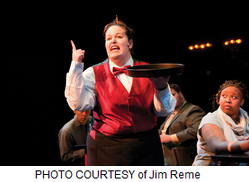Working, a witty and inspirational musical about the average working class citizen opened at the Lauren K. Woods Theatre on Wednesday, March 28. A moderately sized and eager crowd gathered to watch the latest theatrical success to be performed by University students.
The stage was set to satirize the worker mentality with each actor given a designated “cubicle.” Some were stacked on top of each other, a move that gave the actors and actresses much more room to dance and interact without having to leave the stage or stand idly by.
A screen at the top of the set displayed quotes from Studs Terkel, the author of “Working..” “People are hungry for stories. It’s part of our very being. Storytelling is a form of immortality too. Stories pass from one generation to another,” said Terkel. This hunger for stories inspired a musical that was captivating for more than just its catchy music and skillful acting; it was captivating because the musical is about us.
Director and Choreographer Nicole Ricciardi expressed her love of the play’s content. “I like it because every word is true. Every night I hear something different. [This version is] brand new, it’s a complete reworking of the original.”
The actors in Workingplayed members of many different professions, so each role was simply titled, “Man #1” or “Woman #2.” The cast consisted of Brandon Wiener (Man #1), Michael Rosas (Man #2), Henry O. Siebecker (Man #3), Taylor Bogan (Woman #1), Jasmine Walker (Woman #2) and Sarah Clemency (Woman #3). “The play used to have 26 actors,” Ricciardi says. “It was adapted to only use six. It was incredible.”
Considering the variety of roles and responsibilities each performer had to take on, I was skeptical about how well they would do. I was blown away by a combination of distinct personalities and beautiful delivery. If I hadn’t known better, I would’ve thought I was watching a Broadway production.
In Working, the actors and actresses took on a number of different characters and spoke or sang about the hardships, the lessons, the pains and the wonders of being a working-class citizen. These stories covered the entire range of the job industry and were told by an ironworker, a hedge fund manager, a student, a teacher, a trucker, a fireman and many others. These characters were all distinct and unique, with different voices, personas and costumes for every role.
One interesting aspect of Workingwas that the characters, while distinct, also blended in a unique way. At one point, a prostitute and a charity fundraiser both talk about how to be good at their particular business, one must learn to charm and beguile people into parting with their money. Both acknowledge that “you become your job” because “what you do is who you are.”
Another great part was the music. Both the instrumental work and the singing were well designed, fitting the theme and mood of the musical perfectly. A student band played the instruments, building up to the vocals and filling in the silence without overpowering what the performers were doing.
The singing was excellent, sometimes changing the key in the middle of the number to reflect the transformations characters were going through like “Nobody Tells Me How,” which featured a schoolteacher signing about how the classroom and children have changed since she started working. There was also the catchy “Delivery” that described a fast food worker getting away from the counter and bringing food to his hungry customers. I couldn’t help but think, “Where can I buy the soundtrack?”
While witty and entertaining, the play was not without its tragic moments. One scene depicts the life of a retired man who hobbles about stage reminiscing on days gone by. The following scene describes the life of an elderly care worker and a baby sitter. The care worker is saddened by the old man’s deteriorating condition and is reminded of the family he left behind to seek work. The sitter is raising someone else’s daughter while her own daughter remains in another country. Both lament that they’ve sacrificed a great deal to “do the work that no one else will do.”
Jessica Simmons, a junior, really enjoyed the performance. “I thought it was a very moving play. They all did an awesome job,” said Simmons. All the viewers must’ve shared her sentiments; the performance got a standing ovation.
Working wasn’t just fun for the audience; the cast also loved the show. “I enjoy Workingbecause it’s a celebration of the common working man. The audience can relate to it, and that bond with the audience was really the greatest part,” said Michael Rosas, a sophomore.
Alexandra Appolonia, Assistant Director and Choreographer, couldn’t agree more. “It was great to work with such a cast. We had a great connection on and off stage.”
These were but a few of the raving comments that could be heard buzzing between viewers at the show’s conclusion. Every person, viewer and actor alike, had something great to say about the show. Workingis a play that will put a smile on your face even as it makes you cry. It’s definitely worth seeing; you may only be seeing it for one evening, but it delivers a message that will stay with you for a lifetime.
The final two performances of Working are tonight at 8:00 pm and tomorrow, April 5, at 8:00 pm.
PHOTO COURTESY of Jim Reme




